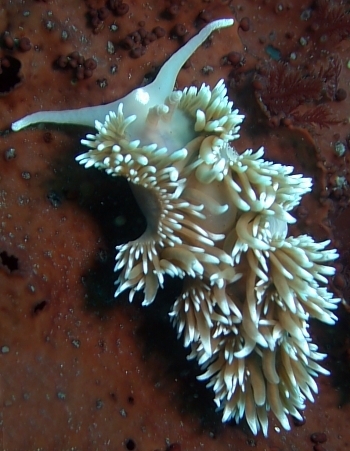
Notaeolidia gigas
Eliot, 1905
Order: NUDIBRANCHIA
Suborder: AEOLIDINA
Family: Notaeolidiidae
DISTRIBUTION
Known from McMurdo Sound, the Antarctic Peninsula and South Orkney Islands at depths from 3 - 50 meters.
PHOTO
Locality: Admiralty Bay, King George Island, Antarctica. 06 February 2003. Photos: Dirk Schories. [www.guiamarina.com/antarctica/]
Notaeolidia gigas grows up to 7 centimeters long and has at and has at least 3 rows of cerata down each side of the mantle edge (more than two hundred on each side).Notaeolidia gigas has been observed feeding on large hydroids, identified as a species of Tubularia. See Notaeolidia depressa for a discussion about the genus.
Note: Photos changed on this Fact Sheet, 16 March 2007, as identity of previous photos [#19612] are problematic.
References:
• Barnes, D.K.A. & Bullough, L.W. (1996). Some observations on the diet and distribution of nudibranchs at Signy Island, Antarctica. Journal of Molluscan Studies 62, 281-287.
• Wagele, H. (1990). Revision of the antarctic genus Notaeolidia (Gastropoda, Nudibranchia), with a decription of a new species. Zoologica Scripta 19(3), 309-330.
• Wagele, H. (1991). The distribution of some endemic Antarctic nudibranchia. Journal of Molluscan Studies 57, 337-345.
• Wagele, H., Bullough, L.W., Barnes, D.K.A (1995). Anatomy of Pseudotritonia Thiele, 1912 and Notaeolidia Eliot, 1905 (Gastropoda: Opisthobranchia: Nudibranchia) from Signy Island, Antarctica. Journal of Molluscan Studies 61, 209-213.
Rudman, W.B., 1999 (February 10) Notaeolidia gigas Eliot, 1905. [In] Sea Slug Forum. Australian Museum, Sydney. Available from http://www.seaslugforum.net/find/notagiga
Related messages
Notaeolidia gigas from King George Island, Antarctica
March 16, 2007
From: Bill Rudman
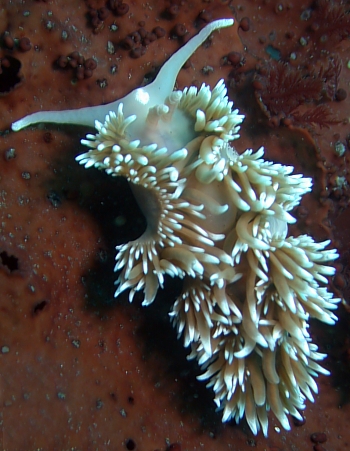
In a recent message [#19656], Michael Schroedl mentioned Dirk Schories' website with nudibranch photos from King George Island, Antarctica. Two animals illustrated in Dirks's website are Notaeolidia gigas, and another aeolid which has been misidentified as that species [see message #19680]. Dirk has kindly allowed me to post his photos of both species on the Forum for comparison.
Notaeolidia gigas has a distinct mantle 'skirt' and the cerata, arranged in irregular rows, are confined inside the 'skirt', which is thrown into sinuous folds. There is also a clear space, free of cerata in the middle of the back, and the rhinophores are shorter and wrinkled.
Locality: Admiralty Bay, King George Island, Antarctica. 06 February 2003. Photos: Dirk Schories. [ http://www.guiamarina.com/antarctica/ ]
This is a very useful set of photos.
Best wishes
Bill Rudman
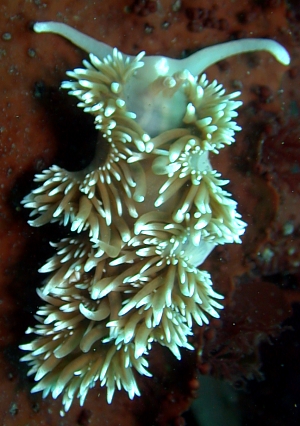
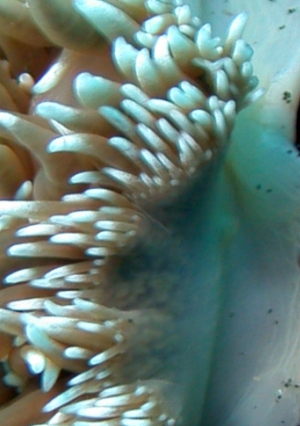
Notaeolidia gigas from Antarctic waters
February 21, 2007
From: David Cothran
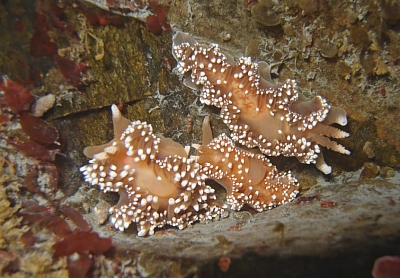
Hi Bill,
I made a dive today at Elephant Island, in the far eastern end of the South Shetlands. In a small area of the rocky wall I found six individuals of what appears to be a species of Notaeolidia, possibly N. schmekelae, though they differ in some respects from the few images I have seen. I first noticed an egg mass on a rhodophyte stalk (shown in the middle right photo - not very sharp but the best I could manage in 1 meter visibility and strong surge ...!): I then found the six animals about 3 meters higher. Three of them were in the group shown in the top photo and, adjacent to them, on another rhodophye, three more that were actively laying (lower photo). Any thoughts on the species ID?
Locality Details: Point Wild, Elephant Island, South Shetland Islands, Southern Ocean. 22 meters, Lengths: 6 -11cm. 19 February 2007. Rock wall. Photos: David Cothran
By the way, this is the site where Sir Ernest Shackelton's men waited for rescue while he made the historic journey to South Georgia in the James Caird.
Best regards
David
david@wandering-eye.com
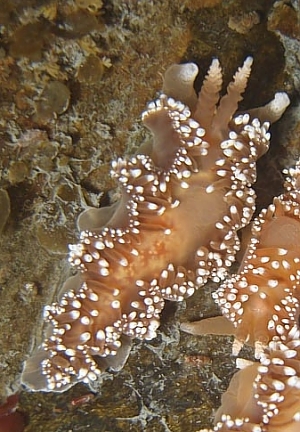
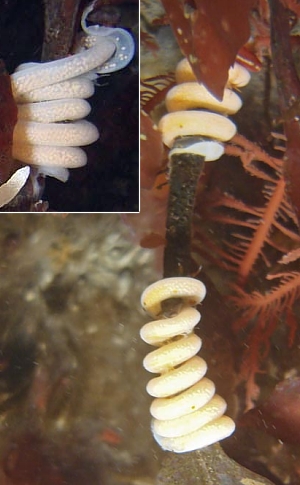
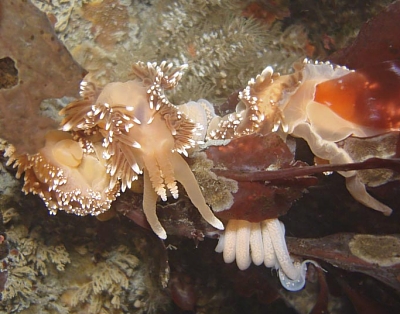
Dear David,
I don't normally post messages immediately - although I wish I could - but I find the thought that we can look at these photos which you took only a few hours ago in Antarctic waters, a good enough reason to jump the queue. I guess if Shackleton had had the internet, he wouldn't have needed to risk his life sailing 1500 km in a 7 m open boat to get help for his stranded crew.
Now to your nudibranchs. The species of this genus are best identified by their internal anatomy, but I am pretty sure your animals are Notaeolidia gigas. Notaeolidia gigas and N. schmekelae are the two largest species, and can have two or three rows of cerata, which your animals seem to do. Of those two species, only N. gigas has been reported from the South Shetland islands and the waters off the Antarctic Peninsula, so I am tentatively sugesting this is N. gigas. It is possible however, that N. schmekelae has just not been found there at present.
The egg ribbons are very interesting. I can't recall seeing egg ribbons reported for any species of Notaeolidia, so this is a valuable find.
Best wishes,
Bill Rudman
Re: Notaeolidia gigas? from McMurdo Sound
February 10, 1999
From: Bill Rudman
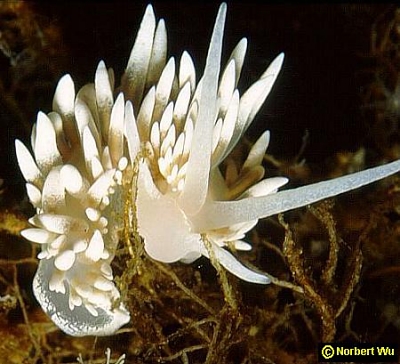
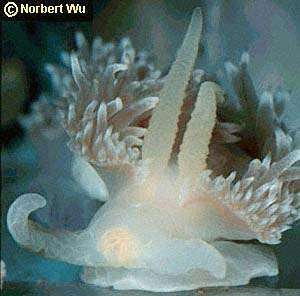
Here are two photos identfied as Notaeolidia gigas from McMurdo Sound, Antarctica. These photos are published with the permission of Norbert Wu from the Underwater Field Guide to Ross Island & McMurdo Sound, Antarctica.
Bill Rudman
Rudman, W.B., 1999 (Feb 10) Re: Notaeolidia gigas? from McMurdo Sound. [Message in] Sea Slug Forum. Australian Museum, Sydney. Available from http://www.seaslugforum.net/find/19612